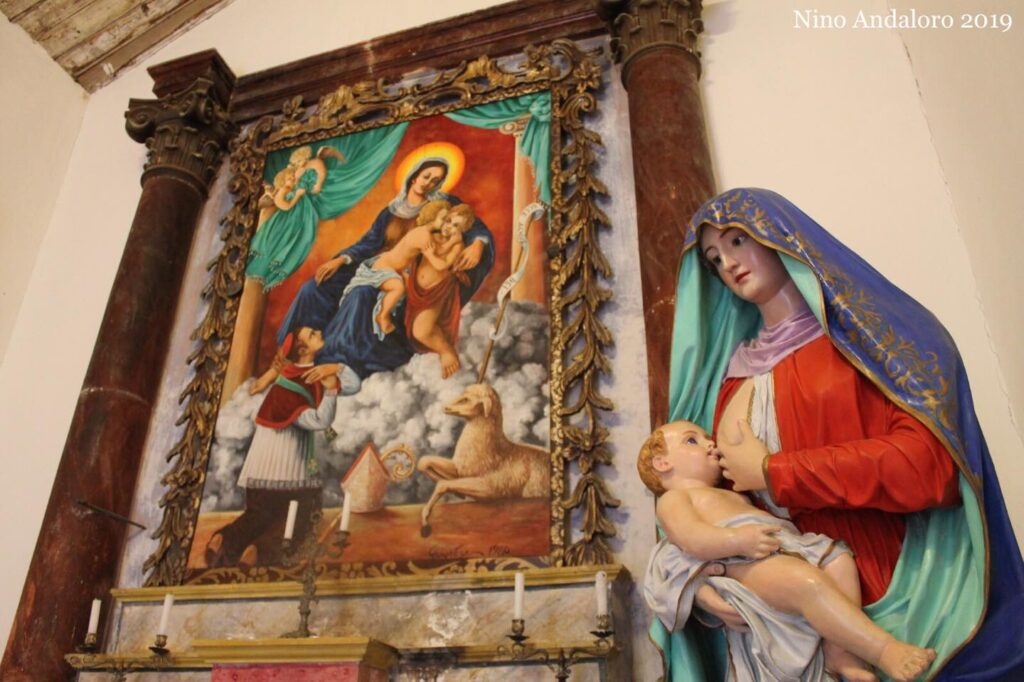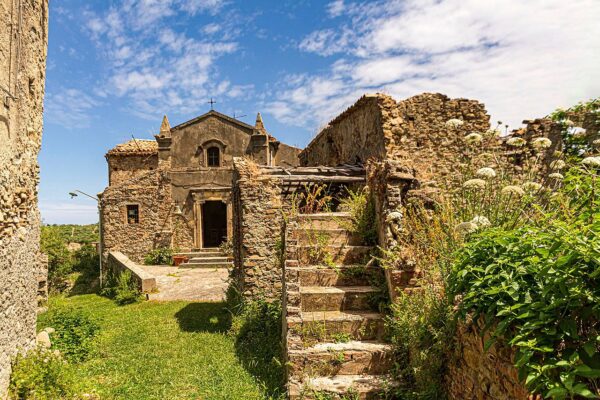Church of Santa Maria delle Grazie

Dating back to the 15th century, it is the oldest sacred place in the district. Built with two regular shapes, a square topped by a triangle, the left body is connected to the building with a large arch and was added later to increase its capacity. Strangely, the building does not have an east-oriented altar, like the traditional east-west arrangement of the apse and threshold. Inside, on the right side you can see the signs of an ancient walled door, while the altar occupies an unusual position, it seems to have been moved.
These and other material and immaterial oddities confirm that originally around 1300 this Church was a small synagogue of the native Jewish inhabitants of Tuscan origin.
The village later developed around this sacred place. The presence of religious authorities in the territory is confirmed by a Bull of Clement VII of 1534 with which the "grangia" of Rometta was elevated to an abbey. The abbot, already archpriest of Rometta, became prior of the entire community and was granted the use of the miter and pontifical. Symbols that are present in the fresco (of little artistic value, but superimposed on another fresco certainly of Jewish origin which has been erased) placed above the main altar of the church in the historic village of Pantano.
It is a typical example of the very simple religious architecture of the 15th century in the valley areas. Inside there is a plaster statue depicting the Madonna clearly breastfeeding the Baby Jesus, the so-called Madonna of Milk. The iconography dates back to ancient Egypt, a time in which images of the goddess Isis intent on breastfeeding her son Horus were widespread and whose cult would last for a long time, intertwining with Christianity. Indeed, many statues of Isis were renamed or venerated as original Madonnas.
This type of Madonna del Latte became very popular in the Tuscan pictorial school. (Not a trivial detail, given the origins of the local inhabitants). In conclusion, we can legitimately state that the cult of the Madonna del Latte has had considerable success since, drawing its origins from the reminiscences of ancient cults on fertility, it has absorbed them into the femininity of the Madonna, cloaking the daily life of emotional relationships, always conceptually present, with sacredness. but so far absent iconographically.
All this, in contrast to the spirit of the Counter-Reformation, (Council of Trent 1543, decree: “De invocation, veneratione, et reliquiis sanctorum et sacris imaginibus) the image of the Madonna who, with a naked breast, suckles the baby Jesus was not “satis decens” that is, sufficiently decorous and could lead to inappropriate thoughts.
Therefore, an image full of spiritual and theological meanings, but at the same time profoundly human and tenderly everyday.
Unfortunately, over the years, due to unprofessional retouching and restoration, the statue has lost both its original soft colors and the decoration of the mantle which was sprinkled with stars that recalled the celestial bodies, another symbolism that has been lost. It still remains to be investigated why the baby Jesus breastfeeds from the right breast of the statue, perhaps because the right cerebral hemisphere is more oriented towards female activities, and the village has always had a matriarchal management?
Another important artefact present in the Church is the painting from the end of the 600s, which was stolen, but of which we have a copy. It depicts Monsignor Giovanni Battista Cannuli, founder of the S. Maria De Pace college, of Rometta, with books in his hand and children around him and other symbolisms that take us back to the Jewish roots of the painting, all in a two-dimensional vision that gives it a sort of perspective already used by Tuscan workers, inaugurated by Giotto and Simone Martini.
The Church hides many mysteries, mainly under the two altars, contradictions that seem to confirm the community's desire to conceal its Jewish roots. These mysteries and in some ways enigmas, belong to the history of the village and confirm the high cultural level of this community, capable of leaving a great enigmatic-mysterious trace in those almost hidden signs, the secret of which they have kept for centuries.
Signs that are still being studied and decoded today for the creation of a map.
Since its birth, the Church has represented the destination of pilgrimages from neighboring towns which every year is renewed on 2 July on the occasion of the religious celebration dedicated to the Madonna delle Grazie.
Source: Text provided by Orazio Bisazza
Card insertion: Ignazio Caloggero
Information contributions: Web
Photo: By Fotografandoversosud - Own work, CC BY-SA 4.0, https://commons.wikimedia.org/w/index.php?curid=108323593
Interior photo provided by Orazio Bisazza (author Nino Andaloro)
Dedicated web area of La Sicilia in Rete: Borgo Pantano online



